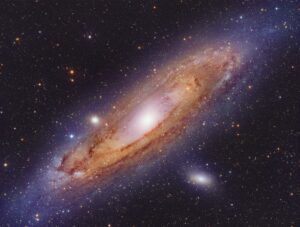RSVP HERE TO RECEIVE THE ZOOM DETAILS: https://marylandnature.wildapricot.org/event-4518743
The universe is not empty. The Hubble Deep Field, an extremely long exposure of a relatively empty part of the sky, provided evidence that there are about 125 billion (1.25×1011) galaxies in the observable universe (many believe this is a very low estimate). Galaxies started forming within first few hundred million years after the Big Bang and evolved over time to what we see today (13.7 billion years and counting), a wide variety of shapes, sizes, color, and environments.
In the fifth and final presentation in the James Webb Experience, Nimish Hathi, Staff Scientist at the Space Telescope Science, will provide an overview of galaxy formation in the early universe and how galaxies must have transformed across the cosmic time based on the Hubble Space Telescope observations and look ahead at how the upcoming James Webb Space Telescope (JWST) will revolutionize our understanding of the first galaxies, by adding new insights into the physical processes that govern galaxy formation and evolution.
Nimish Hathi is a Staff Scientist at the Space Telescope Science Institute (STScI). He received his PhD in Physics/Astronomy from Arizona State University in 2008. During his PhD studies he worked on distant galaxies in the deepest field observed by the Hubble Space Telescope (HST), the Hubble Ultra Deep Field. After his PhD, he was a post-doctoral fellow at University of California (Riverside, CA), Carnegie Observatories (Pasadena, CA), and Laboratory of Astrophysics in Marseille, France, working on understanding physical properties of distant galaxies and how they evolve with time using space-based and ground-based telescopes. He joined STScI in 2017 as an Instrument Scientist for Hubble’s Advanced Camera for Surveys (ACS). In addition to his current work with HST at STScI, he is actively involved in many science development teams for upcoming space-based (James Webb Space Telescope/JWST, Nancy Grace Roman Space Telescope) and ground-based (Rubin Observatory, Thirty Meter Telescope/TMT, Maunakea Spectroscopic Explorer/MSE) facilities.
RSVP HERE TO RECEIVE THE ZOOM DETAILS: https://marylandnature.wildapricot.org/event-4518743

